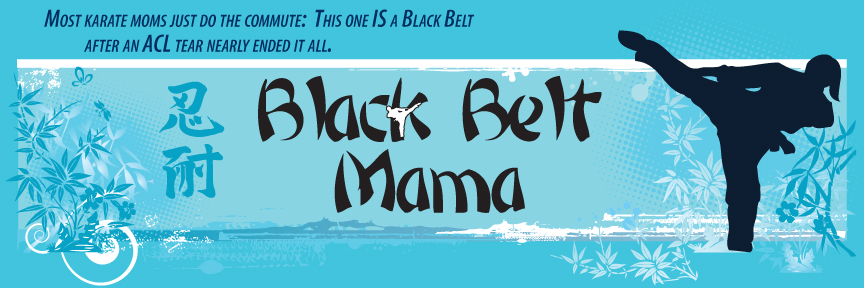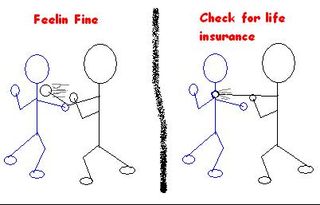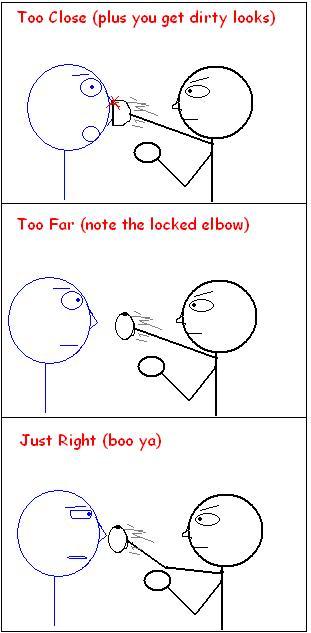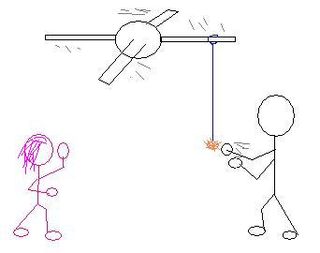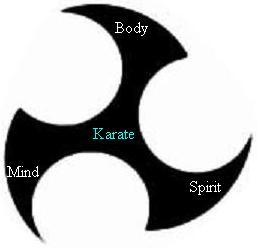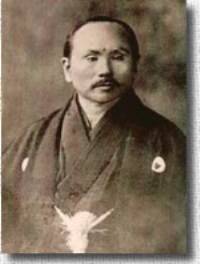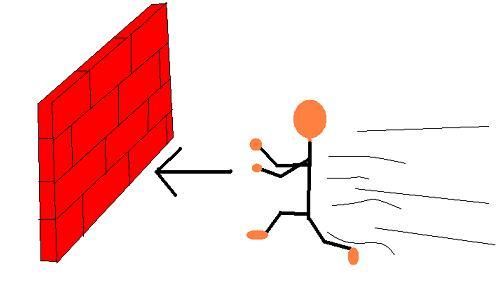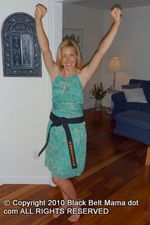The Importance of Control (Less Boring Than It Sounds)
Hey BBM fans, it's my pleasure to hop over from my normal stomping grounds to kick off this month's guest posting. I have some amazing martial artists coming after me so I''ll try not to drop the baton too early (did that ever happen to anyone in high school during track and field day? Mortifying).
I'd like to talk about control today. It's not the sexy side of karate, but control is utterly critical to becoming a mature and successful martial artist. Sure, brick breaking and board snapping is much more impressive on the surface, but some of the most awe inspiring techniques I've seen in my life are the ones that dance the razor's edge of dispatching a live partner.
Power and Control In the Beginning
When first starting a martial art, everyone wants to learn how to hit powerfully. I know I did. In order to learn how to hit with force, one has to be taught good basic body mechanics and striking technique. Luckily, with the kinds of pads, heavy bags, and impact shields found in almost every dojo, this instruction is possible.
Although the martial arts are a very long term endeavor, the basics of proper hitting can be learned fairly quickly. In fact, a common concern for instructors is that students will learn how to hit hard before learning why. This is also one of the reasons that there are both shallow and deep levels of learning in karate. But more on that later.
A Turning Point For Every Student
After a few years of training, every student comes to a crossroad (one of many) where they have to actively decide to improve their control. Unfortunately, this is a narrow path with steep edges on either side.
On one side, you have individuals who are turned off by the thought of pulling punches. They feel that the only way to develop true power is to throw bangers all session every session.
On the other side, you have people who grow accustom to not hitting anything at all. They are comfortable snapping their punches 3-4 inches away from any target in the name of safety and good practice.
Sadly, both of these mindsets are limited. In actuality, proper control needs to be executed at the right distance at full speed. Consider this graphic:
In the first panel, we see an obvious problem as our wayward attacker makes contact with his partner. A punch to the nose is clearly problematic, but strikes that are too hard to any surface of the body can cause injury and distrust amongst fellow students.
The second panel is less dangerous, but just as concerning. The attacker has completed his technique far away from his partner (which you can tell by the full extension of the arm). Although no one got hurt, the attacker is practicing bad distancing and creating habits within himself that can cause issues when trying to use his techniques for real.
The third panel represents a properly executed practice punch. The fist came extremely close without touching, and the arm still has room to 'complete' the technique through the defender, driving the defender's nose and head backward.
Tips For Developing Control
The bad thing about control is that it takes awhile to develop. One thing I do not advise is going around your dojo and throwing full speed punches at people's faces, getting as close as possible until eventually you mess up. That is a quick way to become a dojo pariah. Instead, there are some drills and strategies you can employ to slowly build up your skill.
The first concept utilizes basic focus bags. When training your strikes, take time to practice your power techniques, but also try some controlled reps. See if you can kick and punch so that you are barely scraping the bag. Since no one can get hurt, don't let up on your speed, power, or proper body mechanics. Strike and commit as best you can while pulling the hit.
The second involves a live partner. Forget about face stuff for awhile and focus on the body. Using a relaxed fist, strike in at your partner's abs or chest (this is for control drilling, not vital target practice). Allow your loosened fist to touch your partner, and then retract. You should hear a slight snap of their gi as your light strike touches it.
You can also take your practice home with you. Get some light string and a balled up piece of paper. Attach the ball of paper to the string and hang it from a doorway or ceiling fan blade. The paper is very light, so you'll get a sense of how close you strike by watching the paper's slight movements (or not so slight if you mess up).
If your ceiling fan has a speed slider, or very slow setting, you can make this a game with your kids who might be involved in karate. Just make the fan spin slowly and take turns striking at the paper. It can be fun once someone messes up and the ball starts squiggling as it spins. As you can imagine, this is actually great practice for live sparring control.
Breaking the Glass Ceiling
Proper control isn't just for good dojo etiquette; it's actually critical for learning the deeper aspects of karate and other martial arts. While a punch to the solar plexus or nose is great, there are a ton of other techniques and targets that martial arts can offer.
Palm heel, ridge hand, ippon nukite, etc. + eye, ear, throat, groin, spine, etc. = very risky business.
If a practitioner's mastery of control is anything less than stellar, they'll be unable to utilize these techniques at full speed with the right distancing and timing. Their arsenal will always be limited in variety and effectiveness; they will always be stuck under a glass ceiling, no matter how hard they strike.
While most people think of sparring as the heavily padded event we see today, kumite without padding has been around for much longer. Without pads, karateka were free to target even subtle vital points on each other's bodies and utilize small joint locking tactics. Of course, the problem with sparring without pads is that there needs to be trust and expertise between both parties involved. If you've ever thrown a spear hand technique toward someone's eyes without them expecting it, you know just how strong a reaction some of karate's more vicious techniques can elicit.
Furthermore, most of what we see of kyusho (vital point striking) is done very statically. By that I mean one person stands quite still or throws a single predicted strike, while the uke performs whatever vital point technique he happens to be demonstrating. The reason behind this is both demonstrative and fear-based. Using kyusho without perfect control in a sparring setting can result in illness, injury, or death. Therefore, most kyusho training is done below the glass ceiling because it's too much of a liability to practice otherwise.
Without being completely comfortable using techniques at any range with any sized opponent, and being able to do so correctly, there will always be limits to what a person can learn and use. In other words (if you'll indulge me in this turn of phrase), it's the lightest strike that breaks the glass.
When Control Seeps Over
One of the true gifts of karate lies in the improvements we don't readily see coming. The control I've talked about today is physical. But, in order to train for control, one has to adopt a mindset of control. By making this psychological change, the focus of karate shifts from that of power and strength to reservation and focus.
Mental adaptation tends to be infectious in a very good way. Where emotional outbursts may once have been a natural reaction in every day life, karate's imposed control begins seep in. Furthermore, a person's spirit begins to exude restraint. When that happens, it becomes much clearer when to use karate and not just how. A body, mind, and spirit of control is one of budo. A person who can embody control is one who can follow the martial way.
* * *
Matthew Apsokardu is a 3rd Degree Black Belt in Okinawa Kenpo Karate/Kobudo and student of Muso Jikiden Eishin Ryu. He is also the author of Ikigai | Blogging the Martial Way. To read more from him, visit his website or leave him a message at mapsokardu AT gmail DOT com.
This just in! Admired Martial Arts month just got even more exciting! Anyone who leaves a comment on one of the Admired Martial Artists' posts during the month of March will be entered to win a giveaway prize courtesy of Martial Arts Supplies. Leave a comment on each post, and check back often. The more comments you leave, the more chances you have to win! More giveaways are in the works! For details, go here!
Where Will We Take the Martial Arts?
An Exploration Into the Classical Ways of Training
BY: MATTHEW APSOKARDU
The world is arriving at a critical point in martial arts transmission. Fewer and fewer original masters remain from direct Asian lineages of the various fighting arts. Leading the way now is the first generation of global students. These soldiers and students from the U.S., along with areas like Europe and Australia, are becoming the key to proper transmission of classical martial arts.
While these few men and women struggle to transmit their knowledge fully, they must battle against the behemoth that is modernization and capitalism. Karate and tae kwon do schools pop up in every strip mall, offering quick belts and flashy techniques with no obligation required except monetary compensation.
Nor can we underestimate the impact of Mixed Martial Arts. MMA offers an eclectic amalgam of techniques while forgoing activities like kata. MMA has produced many great fighters and is a legitimate form of combat exercise – but also steers many potential students away from traditional training.
Truly, it is up to the next generation, the kyu ranks and lower dan ranks of every style, to learn how to learn the old way; to refuse the easy gratification of trophies, money, and false notoriety and pursue the intangible goals of the past.
The big question is – how do we go about training classically?
The following are a few quick tips with that goal in mind. This is a very sparse list; simply some key points that I believe are important and that I continue to work on personally. This is not an analysis of techniques, nor is it a guide to sparring. But for those seeking something of the old budo heart, it may be helpful.
In trying to keep things "old style", I would like to break down my suggestions in traditional karatedo fashion – Body, Mind, and Spirit.
TO TRAIN YOUR BODY:
Stick Around
If you want to get anything out of a classical style, you have to stick around. Six months won’t cut it. Six years won’t cut it. The way old-style teaching operates is through repetition and muscle memory. After developing a rock solid foundation, instructors will then teach you how to work outside of kata and routine drills. But if you ditch once you get a first degree black belt, all you’ve got is a couple of prearranged exercises. Not very useful against a live opponent.
Many of the most advanced techniques found in old arts are just extraordinarily refined basics. Strikes made with perfect timing at precision targets, delivered in a strategic order, result in some stunning effects (if you’ll excuse the pun). It takes a while to learn these targets, and even longer to utilize them correctly against free-willed opponents who don’t feel much like getting hit.
The best way to ensure ‘sticking around’ is to first realize what you want in a core style. Look into different styles and realize which fits your lifestyle and body type. Once you’ve established that, keep it your core style and develop around it (to learn more about this training theory, consult Forrest Morgan’s "Living the Martial Way.") Remember, sports are sports. Some schools simply don’t teach classical theories, so if you want them, keep looking.
Investigate
Do your homework! Don’t cringe, just do it. Actually…cringe. The martial art universe is epically large and hard to put together. When you first begin studying, it will seem all but impossible to put your own style’s history together, let alone how it interacts with all the other styles, and how those styles interact with other countries, and so on and so forth. Even now when I think about the vast martial scape it makes my head spin. But the old masters made it their business to know such things, and so must we. Not to mention, by reading from credible sources and watching videos of legitimate masters, any martial artist’s eyes can be opened to an array of concepts and ideas they never considered before; and the best part is, it doesn’t matter what rank you are. There WILL be something to learn.
Remember, the old Okinawan sensei intermingled their ideas and techniques. They bounced concepts off of each other in the hopes of refining their systems. They learned from multiple instructors and utilized those techniques that worked best (yes, it’s true. You eclectic folk can remind your hard-lining friends).
TO TRAIN YOUR MIND:
Don’t Obsess Over Rank
Ranking in martial arts started off innocently enough – Jigoro Kano wanted to gauge the progress of his students. Unfortunately, rank has become a bit of a monster and brings out negative qualities in a lot of people. Many lust after rank. Many abuse it once it’s attained. Others will cheat and barter just to get it. This is not at all what was originally intended.
The old budo styles were used to prepare samurai, and to a lesser extent soldiers, for battle. Sword cuts, empty hand techniques, spear thrusts…as much as they could pack into the minds of the combatants before war began. There was no time and no need for rank because one simple factor evaluated your skill level – whether or not you lived.
It’s ok to feel grateful and honored as rank comes to you, but putting more stock in it than that can lead to some of the troubling situations we see abundant today.
Optimize your mental acuity
Mental prowess is very valuable. Being able to effectively process that which you see and how you react is one of the benefits of martial art training. But there is a lot more to it. Mushin is a term that roughly translates to "no mind" and refers to a complete readiness and quieting of the mind. When a karateka effectively utilizes mushin, processing what you see and reacting is no longer necessary - there is simply reaction. Beyond mushin is zanshin, roughly translated as "remaining mind." Zanshin helps keep a martial artist aware of his surroundings at all times and alert for that which may come. One who utilizes zanshin is aware of the position of the sun, the condition of terrain, and every movement of his opponent. Forrest Morgan equates it to a wolf that hovers over his opponent, teeth bared and ready to break his opponent’s neck at the first sign of movement.
One who trains in mushin and zanshin may begin to develop the Budo ideal of Shugyo No Mokuteki. Or as Miyomoto Musashi explained it, "a mind as high as Mt. Fuji…you can see all things clearly. And you can see all the forces which shape events; not just the things happening near you." By developing your mind in this manner, conflict can be resolved or avoided before it begins.
In order to reach mushin a heavy emphasis on kata should be maintained. Kata can be a mobile form of meditation and teaches the body, through extensive repetition, to move without conscious thought.
To reach zanshin, a martial artist must carry their art with them at all times. They must constantly analyze scenarios, environments, body language, and ‘gut feelings’ experienced in the hara (lower abdomen region). This, combined with dojo training and kumite, is critical.
Explore without Deviation
One of the biggest complaints about older arts is their seemingly stodgy nature. Moves in kata seem quaint and unrealistic. They appear completely unresponsiveness to the ever-changing nature of attackers.
That’s true…if you never explore. Kata, or prearranged attack-defense sequences, are useful as learning devices. The concepts in each kata are carefully devised, multipurpose actions that, once ingrained in the mind, can become infinitely useful. Once technique and good habits are reflexive instead of thought-induced, the practitioner can more fully explore the art (and thus scenario, intent, opponent, and other variables are opened up for consideration).
Unfortunately, problems arise with hardcore explorers. Sometimes, they fall in love with their own interpretation and decide to change kata and material entirely. These people believe they are changing things for the better. For that specific person, maybe it is better. But kata and traditional arts are designed to train everyone, and can flex for specific needs, but must be flexed back to their original form if they are to be sustained for future students.
Think of kata as a book. You first read the words in the book, but then your imagination takes hold and creates a whole world around those words. You wouldn’t go changing the words to better fit your imagination would you? No, because then the next reader won’t be able to explore the original masterpiece.
TO TRAIN YOUR SPIRIT:
Realize the Purpose
Karate and other traditional arts are not simply about fighting. They are about Life Protection (if I may borrow a term from a writer later in this month – Kyoshi Bill Hayes). The classical martial artist protects those around him/her and even protects the lives of wayward attackers by withholding technique as much as possible; but if the situation demands it, responds with devastating consequences. Furthermore, practitioners of do arts (karatedo, judo, taekwondo, kyudo, kendo, iaido, hapkido, aikido, etc.) concern themselves with following "the way."
On the surface, "the way" of any martial art is simply the unique approach that art takes toward combat. "The way" of aikido involves melding with an opponent’s energy and using their own force against them. "The way" of tae kwon do is the utilization of both hand and foot techniques, but with a strong emphasis on kicking. These stylistic differences are notable, but not really the reason the old masters placed do on the end of their arts. Instead, they intended "the way" to be a path in which students could build their character and reach self actualization.
To better understand such character building, here are just a few precepts written by Funakoshi Gichin, founder of Shotokan Karate and considered the father of Japanese karate:
– Karate-Do strives internally to train the mind to develop a clear conscience, enabling one to face the world honestly, while externally developing strength to the point where one may overcome even ferocious wild animals. Mind and technique become one in true karate.
– Just as it is the clear mirror that reflects without distortion, or the quiet valley that echoes a sound, so must one who would study Karate-Do purge himself of selfish and evil thoughts, for only with a clear mind and conscience can he understand that which he receives.
– He who would study Karate-Do must always strive to be inwardly humble and outwardly gentle. However, once he has decided to stand up for the cause of justice, then he must have the courage expressed in the saying, "Even if it must be ten million foes, I go!" Thus, he is like the green bamboo stalk: hollow (kara) inside, straight, and with knots, that is, unselfish, gentle, and moderate.
– To win one hundred victories in one hundred battles is not the highest skill. To subdue the enemy with out fighting is the highest skill.
– When you look at life think in terms of karate. But remember that karate is not only karate — it is life.
In order to better understand Funakoshi Sensei, we must scrutinize all of our actions, even when no one is looking. We have to let the perfection we strive for in technique infect the way we think, so that flaws in character are slowly chipped away through the power of will. Anything less falls short of our founder’s ideals. Furthermore, we need to remind ourselves that martial arts are a lifelong endeavor, and no matter what, there is always a way to improve.
In our modern time, transmission of these classical ideals can be very difficult. Parents bring children to various dojo in order to learn self-defense, not to be preached at. Furthermore, they are concerned that Asian philosophies that resemble Shinto and Buddhism will interfere with their chosen faith. Generally, the concept of ‘respect’ is well received; but once ‘honor’, ‘humility’, ‘veracity’, etc. make an appearance, the acceptance isn’t as ready. It’s a very tricky mire to navigate, and that is why every student must take it upon themselves to study and investigate such concepts on their own. If they’re lucky, they will meet an instructor who is willing to help them along the way.
Consider Body/Mind/Spirit
Separately, each is useful; but it’s the harmonic coordination of the three that makes a classical martial artist. If one branch exists without the other, the journey is incomplete. Only by training in all three can we achieve that indescribable characteristic so noticeable in the old masters – Heijo Shin: A peaceful mind.
In Conclusion – "Part the Clouds, See the Way"
This may all sound like a bit much. No lie, it’s a handful. But the senior teachers out there right now went through the same ordeals, and even more. It’s up to us, the lower ranks, to receive as much of their knowledge as we can and to avoid slipping off the right path. I don’t write this as one who has accomplished everything, but as one who struggles alongside you. Hopefully, together, we can all keep the true nature of the martial arts alive!
MA
For BBM, From the Okinawa Kenpo Side
Hello BBM Readers! It is my privilege to write for BBM today while she is going through her recovery. I’m sure all of our well wishes are with her!
Just as a quick note – this post will not contain any information about underwear or pimped out crutches; those things are specialties of BBM and I couldn’t possibly encroach on her territory (not to mention I might incur the BBM wrath). But what I WILL try to do is offer something useful in the karate realm.
Holding True with a Wandering Mind
Matthew Apsokardu
One concept I keep running into during my training is balance. Some say yin and yang, others say in and yo. But basically it boils down to giving two opposing forces their fair share. If I train my right hand, I should train my left hand. If I practice punches, I should practice kicks. If I develop my body, I should develop my spirit. You can see how infinite these little examples can be (10,000 conflicts, the Japanese might say). But there is one kind of balance that has struck me lately and I would like to investigate it………
Have you ever found yourself puzzling over a tough math equation, but continuously getting stuck? How about trying to brainstorm an English paper (especially when it’s due the next day), but suffering from crampy writer’s block? I think we’ve all felt the hair tugging frustration these situations invoke. At these moments, it’s likely you do what most people do – get up and give yourself some breathing space. Let your brain air out. And when you sit back down, the problem at hand looks completely different, and not so terrible.
I believe the same can be true for karate.
In general, martial arts training is very gung-ho. We tend to go full-out, 110%. And that’s a good thing. Without that kind of commitment it’s impossible to become truly great at anything. But in karate, just like with the math equation, it’s very easy to run into seemingly insurmountable problems. However, UNLIKE the math equation, many karate practitioners have a hard time stepping back. They feel discouraged at their lack of progress and try to push their material harder and harder.
Consider this visual –
This unfortunate karateka keeps running headlong into that beautifully crafted brick wall. He’s a karate man, so he should be able to pound through it, right? Well…maybe, but what happens if he relaxes for a moment and let’s his mind wrap around the situation –
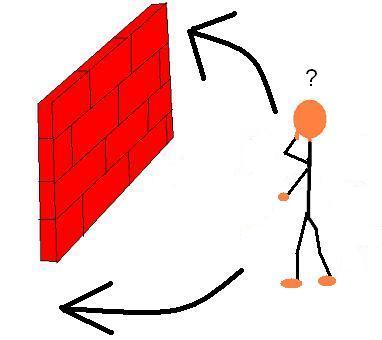
Look at that! Ohh he’s a quick one.
Seems silly and intuitive, I know. But I actually poke fun at MYSELF with these pictures because it wasn’t until recently when I took a step back from karate that I began to see it in a whole new light. I noticed many awkward, unnatural things I was doing, and how easily I could improve myself. Also, certain solidified concepts in my mind began to merge with floating ideas that I developed outside the dojo. Such combinations would not have occurred without a little bit of distance.
My budo instructor has a saying – "Sometimes martial arts can be like rolling down a train track with blinders on. It’s very easy to chug along, always straight ahead."
I’m tending to agree, more and more. I believe a practitioner should train hard and chip away at all their imperfections, but also take time to step back. Refocus. Reconsider things, especially after they’ve become stagnant with repetition. I’d like to quote another great instructor who has a newsletter called Okinawa No Shorin-Ryu Karate-do Kenkyu-Kai Shimbun. In it, he says – "When the young study karate it is ok for it to be recreational, but, when more mature practitioners train it should be re-creational."
MA
—————————————-
A Final thought – Some people are given bad situations like BBM – she is forced into a training hiatus due to surgery. But just imagine the amazing opportunity she will have to really examine the way she learns and the way her body changes (especially in mobility) as time passes.
